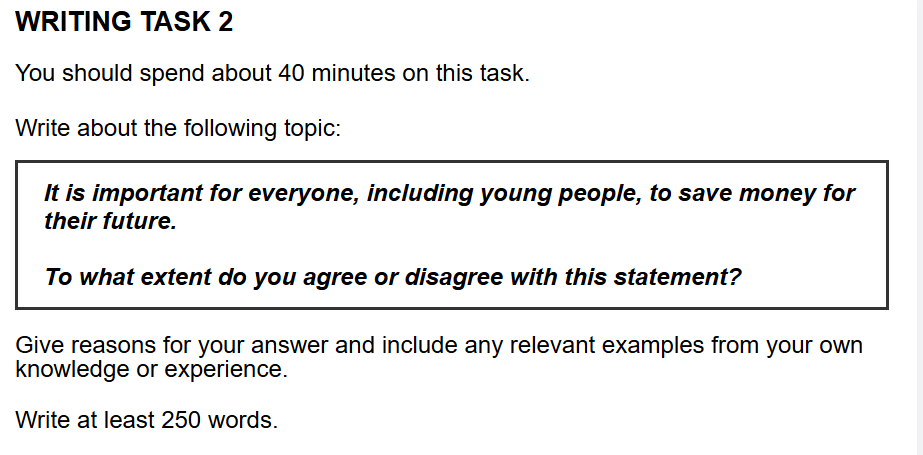My-IELTS-subjective
题目

范文
好的,没问题!我们马上开始。面对一个全新的雅思写作题目,最可靠的方法就是运用一个清晰、有逻辑的框架来组织思路和语言。
今天我们就以你提供的这个关于“存钱”的题目为例,严格按照你给我的P-C-C-E-L 深度逻辑写作框架,来完成一篇符合 7.5 分标准、语言简洁、逻辑清晰的范文。
第一步:写作思路 (Brainstorming & Outlining)
在我动笔之前,我的大脑会像这样快速运转,用 1-2 分钟确定文章的核心骨架:
-
审题:
- 话题: 为未来存钱的重要性 (saving money for the future)。
- 对象: 每一个人,特别提到了年轻人 (everyone, including young people)。
- 问题: To what extent do you agree or disagree? (多大程度上同意或不同意?)
- 我的立场: 毫无疑问,完全同意 (Strongly Agree)。这是一个非常主流且容易论证的观点。
-
构建大纲 (根据 P-C-C-E-L 模型):
- 引言: 背景(理财很重要) -> 改写题目 -> 亮明观点(我完全同意),并预告两个理由。
- 主体段 A (理由一):为了应对未来的不确定性。
- P (Point): 存钱是建立经济保障、抵御未知风险的关键。
- C (Cause): 为什么需要保障?因为未来的就业市场因科技发展而
充满变数 (increasingly unpredictable)。 - C (Consequence): 结果是什么?人们可能面临
失业 (job displacement),需要钱来过渡或提升技能 (reskilling and upskilling)。 - E (Example): 比如,一个工厂工人被自动化设备取代后,需要一笔存款来支撑他学习新技能(如编程)期间的生活。
- L (Link): 因此,储蓄是适应未来变化的重要工具。
- 主体段 B (理由二):为了实现个人长期目标。
- P (Point): 储蓄是实现重大人生目标的基石。
- C (Cause): 为什么?因为像买房、接受高等教育或组建家庭这些
人生里程碑 (major life milestones)都需要大笔资金。 - C (Consequence): 结果是什么?有储蓄的人可以主动追求这些目标,而没有储蓄的人则可能
陷入债务 (fall into debt)或错失机会。 - E (Example): 一个典型的例子就是,年轻人为了支付
房产首付 (a down payment on a property)而进行储蓄。 - L (Link): 所以,存钱是主动规划理想人生的实际行动。
- 结论: 重申观点(存钱至关重要) -> 总结两个理由(应对风险+实现目标)-> 提出一个有力的收尾(从小培养储蓄习惯是通往财务独立的基石)。
思路清晰了,现在我们就可以把这些想法填充成一篇完整的文章。
第二步:雅思 7.5 分范文
In today’s world, the ability to manage personal finances is becoming an essential life skill. The question of whether saving money for the future is a vital habit for everyone, particularly for young people, has sparked considerable discussion. Personally, I wholeheartedly endorse this view, primarily because it provides financial security against future uncertainties and enables the achievement of long-term personal goals.
First and foremost, establishing a savings habit is crucial for building a financial safety net to handle unforeseen challenges. The main reason for this is that the future job market is increasingly unpredictable, largely due to rapid technological advancements like automation and artificial intelligence. As a consequence, individuals may face unexpected job displacement or the need to transition to new careers, which often requires both time and money for reskilling and upskilling. A compelling illustration is a factory worker whose job is automated; a savings fund would provide the necessary support for them to enroll in a coding bootcamp and re-enter the workforce. Hence, it becomes apparent that having a financial cushion is a vital tool for navigating an ever-changing world.
Furthermore, saving money is fundamental to achieving major life milestones. This can be attributed to the fact that significant life events, such as purchasing a home, pursuing higher education, or starting a family, are capital-intensive. This, in turn, allows individuals to proactively work towards their aspirations without the burden of falling into debt. A clear illustration is the common practice among young professionals of saving diligently for several years to afford a down payment on a property. Thus, the act of saving is not merely about accumulating wealth, but about empowering oneself to build a desired future and maintain financial independence.
In conclusion, I reaffirm my conviction that the practice of saving money is indispensable for people of all ages. Based on the reasoning that it offers a buffer against economic shifts and provides the financial means to realize personal ambitions, the importance of this habit cannot be overstated. Ultimately, cultivating the discipline of saving from a young age is one of the most reliable paths toward financial well-being and a secure future.
(Word Count: 338 words)
第三步:好词好句分析 (Language Analysis)
这篇范文使用了简洁而精准的词汇和句型,我们来分析一下:
financial security/financial safety net(经济保障 / 经济安全网): 这是非常地道的搭配,准确表达了存钱的首要目的。比只说 “have money” 要高级得多。increasingly unpredictable(越来越不可预测): 这个副词+形容词的组合,精准地描述了就业市场的动态变化。job displacement(工作岗位流失): 这是一个非常专业的术语,特指因为技术或经济结构变化导致的失业,比 “losing jobs” 更学术。reskilling and upskilling(再培训和技能提升): 这是目前教育和就业领域的热门词汇,表明你对现代社会趋势的了解。major life milestones(重大人事里程碑): 这是一个非常形象的表达,概括了如结婚、买房、生子等人生大事。falling into debt(陷入债务): 地道的动词搭配,准确表达了没有储蓄可能导致的负面后果。a down payment on a property(房产首付): 非常具体且贴切的例子,让论证更有说服力。financial well-being(财务健康/幸福): 这是一个更全面的概念,不仅指有钱,更指一种健康的财务状态和心态,用在结尾处可以提升文章的立意。
第四步:总结与模板提炼 (Template Generation)
现在,我们把这篇范文的“血肉”(具体话题内容)剥离,只留下它的“骨架”(逻辑和结构),你就得到了一个可以应用于任何“同意/不同意”类题目的高分模板:
引言段 (Introduction)
In today’s world, [宏观背景介绍]. The question of whether [转述题目中的观点] has sparked considerable discussion. Personally, I wholeheartedly endorse this view, primarily because [你的理由一] and [你的理由二].
主体段 A (Body Paragraph A)
First and foremost, [陈述理由一的分论点]. The main reason for this is that [解释观点成立的深层原因]. As a consequence, [阐述该原因会带来的直接结果]. A compelling illustration is [给出一个具体的例子来支撑结果]. Hence, it becomes apparent that [重申分论点一与全文观点的联系].
主体段 B (Body Paragraph B)
Furthermore, [陈述理由二的分论点]. This can be attributed to the fact that [解释观点成立的深层原因]. This, in turn, allows/leads to [阐述该原因会带来的直接结果]. A clear illustration is [给出一个具体的例子来支撑结果]. Thus, [重申分论点二与全文观点的联系].
结论段 (Conclusion)
In conclusion, I reaffirm my conviction that [用不同的话重申你的核心立场]. Based on the reasoning that [总结理由一] and [总结理由二], the importance of this cannot be overstated. Ultimately, [提出一个具有前瞻性的思考或建议,升华全文].
希望这次的拆解和讲解对你有帮助!你可以随时用任何一个新的题目来套用这个思路和框架进行练习。我们今天想学习下一个知识点,还是解答一些你自己的疑问呢?